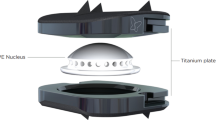Summary
This study examined effect of a new intervertebral cervical disc prosthesis in relieving the neurological symptoms and signs, improving the patients’ ability to perform daily activities, reducing pain, and maintaining the stability and segmental motion. From December 2003 to October 2004, 12 patients, who had received 14 replacements of cervical artificial discs, were followed-up for 2 to 8 months (with a mean of 5.2 months). Of them 5 had cervical spondylotic myelopathy and 7 had cervical disc herniation. The patients included 7 males and 5 females, with their age ranging from 35 to 62 y and a mean of 50.3 y. Single-level replacements were performed in 10 cases and 2 cases received two-level replacement. Operation time of the single-level surgery averaged 130±50 min and the time of two-level surgery was 165±53 min on average (from skin incision to skin suturing). Neurological or vascular complications during or after surgery was not observed. Japanese Orthopedic Association scores (JOA scores) increased from 8.6 to 15.8 on average. There was no prothesis subsidence or excursion. Replaced segments were stable and the range of motion was partially restored, being 4.68° (3.6°–6.1°) in flexion and extension position and 3.51° (2.5°–4.6°), 3.42° (2.6°–4.3°) in left and right bending position. No obvious loss of physiological curvature was noted. CT or MRI follow-up showed that excursion was less than 1.5 mm) in 2 of 14 levels and between 1.5 mm and 3 mm) in 1 of 14 levels. No ossification in the replaced levels was observed. It is concluded that satisfactory short-term results were achieved in the 12 cases of artificial disc replacements. Different from anterior cervical discectomy and fusion, the replacement could achieve quick functional recovery and did not lead to the movement limitation of cervical vertebrae. At least a 5-years follow-up was needed to assess the long-term effect of the prosthesis on its neighboring segments.
Similar content being viewed by others
Reference
Goffin J, Calenbergh F V, Loon J V et al. Intermediate Fellow-up After Treatment of Degenerative Disc Disease With the Bryan Cervical Disc Prosthesis:Single-level and bi-level. Eur Spine J, 2003,28(4):2673–2678
Matsunaga S, Kabayama S, Yamamoto T et al. Strain on intervertebral discs after anterior cervical decompression and fusion. Spine, 1999,24(7):670–675
Pospiech J, Stolke D, Wilke H et al. Intradisc pressure recordings in the cervical spine. Neurosurgery, 1999, 44(2);379–384
Hilibrand A S, Carlson G D, Palumbo M A et al. Radiculopathy and myelopathy at segments adjacent to the site of a previous anterior cervical arthrodesis. J Bone Joint Surg (AM), 1999,81(4):519–528
Mayer H M, Wiechert K, Korge A et al. Minimally invasive total disc replacement: Surgical technique and preliminary clinical results. Eur Spine J, 2002,11(suppl 2):124–130
Goffin J, Casey A, Kehr P et al. Preliminary clinical experience with the Bryan Cervical Disc Prosthesis. Neurosurgery, 2002,51(3):840–845
Sekhon L H. Cervical arthroplasty in the management of spondylotic myelopathy. J Spinal Disord Tech, 2003,16(5):441–449
Bryan V E. Cervical motion segment replacement. Eur Spine J, 2002,11(Suppl 2):92–97
Wiffield C C, Skrzypiec D, Jackowski A et al. Internal stress distribution in cervical intervertebral discs: the influence of an artificial cervical joint and simulated anterior interbody fusion. J Spinal Disord Tech, 2003, 16(5):441–449
DiAngelo D J, Roberston J T, Metcalf N H et al. Biomechanical testing of an artificial cervical joint and an anterior cervical plate. J Spinal Disord Tech, 2003,16(4):314–323
Wigfield C C, Giu S S, Nelson R J et al. The new Frenchay artificial cervical joint:results from a two-year pilot study. Spine, 2002,27(22):2446–2452
Cummings B H, Robertson J T, Gill S S. Surgical experience with an implanted artificial cervical joint. J Neurosurg, 1998,88(6):943–948
Pointillart V. Cervical disc prosthesis in humans: Frist failures. Spine, 2001,26(5):90–92
Author information
Authors and Affiliations
Additional information
YANG Shuhua, male, born in 1954, Professor
Rights and permissions
About this article
Cite this article
Yang, S., Hu, Y., Zhao, J. et al. Follow-up study on the motion range after treatment of degenerative disc disease with the Bryan cervical disc prosthesis. J. Huazhong Univ. Sc. Technol. 27, 176–178 (2007). https://doi.org/10.1007/s11596-007-0218-7
Received:
Issue Date:
DOI: https://doi.org/10.1007/s11596-007-0218-7




